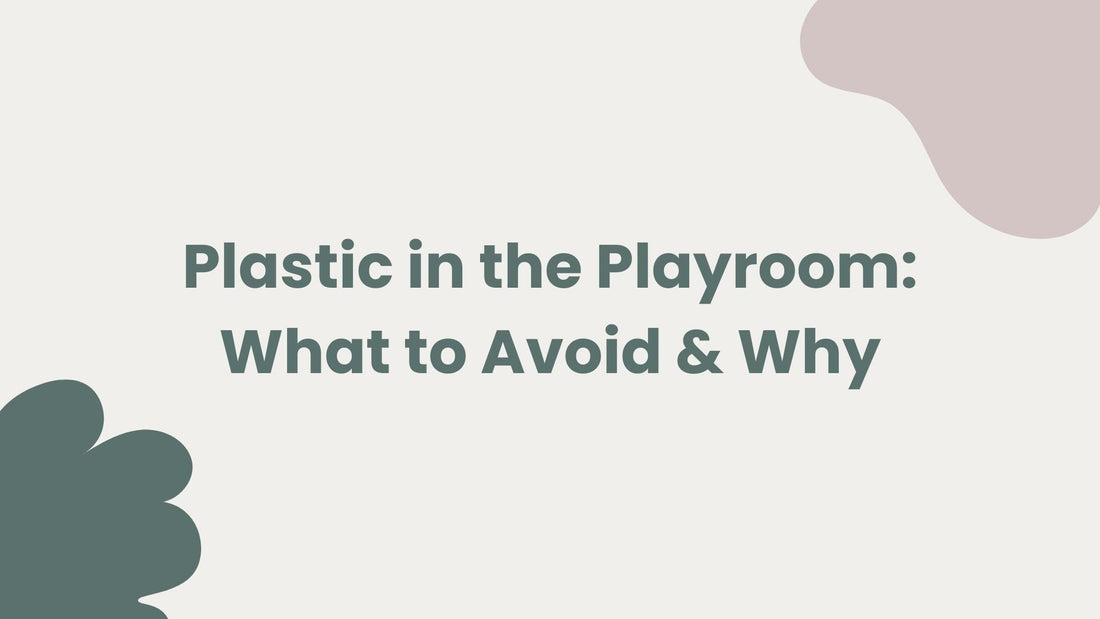
Plastic in the Playroom: What to Avoid & Why
Share
Introduction
Playtime is a cornerstone of childhood development, but did you know that many conventional toys contain plastics and chemicals that can be harmful to babies? Choosing safe alternatives is a key part of sustainable parenting and eco-parenting.
In this guide, we’ll explore the plastics to avoid, the reasons behind them, and how to create a playroom filled with eco baby toys that support raising a child sustainably. By making smarter choices, parents can ensure a safe, healthy, and environmentally friendly play environment.
Why Avoid Plastic in the Playroom?
Plastics are everywhere in modern toys, but many contain BPA, phthalates, PVC, and other chemicals that can leach into a child’s environment. Exposure to these substances may contribute to developmental, hormonal, and health issues.
The benefits of a plastic-free or low-plastic playroom include:
- Healthier Playtime: Reduced exposure to harmful chemicals.
- Environmental Responsibility: Less plastic waste contributes to a cleaner planet.
- Durability & Longevity: Non-toxic, natural materials often last longer than cheap plastic toys.
- Support for Sustainable Parenting: Encourages conscious consumption and eco-conscious habits.
Plastics to Avoid in Baby Toys
- BPA (Bisphenol A) – Often found in hard plastic toys, bottles, and sippy cups. Linked to hormonal disruption.
- PVC (Polyvinyl Chloride) – Found in cheap soft plastics, often containing phthalates.
- Phthalates – Used to soften plastics; can affect hormone levels.
- Styrene – Present in some foam and hard plastic toys, with potential health risks.
Eco-Friendly Alternatives for the Playroom
1. Bamboo Toys
- Strong, durable, and naturally anti-bacterial.
- Perfect for teething, stacking, or sensory play.
2. Organic Cotton & Wool Toys
- Soft, safe, and sustainable.
- Excellent for cuddly toys and imaginative play.
3. Silicone Toys
- Food-grade silicone is safe, flexible, and easy to clean.
- Great for teething, bath play, and creative activities.
4. Wooden Toys
- FSC-certified wood supports responsible forestry.
- Can include building blocks, puzzles, or shape-sorters.
5. Recycled & Upcycled Materials
- Toys made from recycled fabrics, paper, or wood reduce environmental impact.
- Teach children about reusing and sustainability from an early age.
Tips for a Safe, Plastic-Free Playroom
- Check Labels Carefully: Look for BPA-free, phthalate-free, PVC-free, and non-toxic certifications.
- Prioritise Durability: Durable materials reduce the need for frequent replacements.
- Mix & Match Materials: Use bamboo, silicone, wood, and organic textiles to create variety.
- Include Eco Baby Toys: Support toys that are educational, non-toxic, and environmentally friendly.
- Educate Through Play: Introduce children to sustainability concepts through eco-conscious toys and activities.
Top Picks for a Plastic-Free Playroom
- Bamboo Stacking Blocks – Eco-friendly, safe, and long-lasting.
- Organic Cotton Plushies – Soft, non-toxic, and perfect for cuddling.
- Silicone Teethers & Bath Toys – Safe for sensory and teething play.
- Wooden Shape Sorters & Puzzles – Durable, educational, and non-toxic.
- Recycled Material Craft Kits – Fun, creative, and sustainable.
Why Sage & Snuggle is Your Go-To for Plastic-Free Playrooms
Sage & Snuggle offers a curated range of eco baby toys and non-toxic baby products designed for parents who care about safety, sustainability, and fun. Our products support eco-parenting, encourage raising a child sustainably, and make playtime safe, educational, and joyful.
Conclusion
Creating a plastic-free playroom is more than a trend. It’s an investment in your child’s health, your family’s environmental impact, and the planet’s future. By choosing eco-baby toys, wooden and bamboo alternatives, and non-toxic products, parents can embrace sustainable and eco-parenting values while nurturing a child safely and creatively.
Turn your playroom into a safe haven that promotes learning, imagination, and raising a child sustainably.
